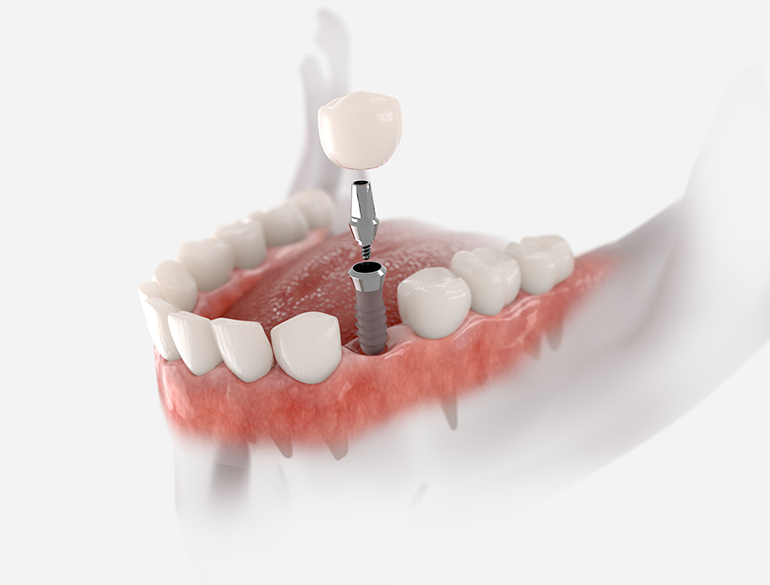The Ultimate Guide To Dental Sense
The Ultimate Guide To Dental Sense
Blog Article
Excitement About Dental Sense
Table of Contents10 Easy Facts About Dental Sense ExplainedExcitement About Dental SenseThe Main Principles Of Dental Sense Dental Sense - An Overview
are medical devices operatively implanted right into the jaw to restore an individual's ability to chew or their look. They give support for synthetic (phony) teeth, such as crowns, bridges, or dentures. When a tooth is lost due to injury or disease, an individual can experience problems such as fast bone loss, faulty speech, or modifications to eating patterns that result in discomfort.Oral dental implant systems contain an oral implant body and oral implant abutment and might additionally include an abutment addiction screw. Kids dental. The oral implant body is surgically put in the jawbone instead of the tooth's root. The dental implant abutment is normally connected to the dental implant body by the abutment fixation screw and expands via periodontals right into the mouth to support the attached artificial teeth
(https://pubhtml5.com/homepage/vtrmy/)Framework of The Oral Implant System picking oral implants, speak with your oral supplier regarding the potential benefits and dangers, and whether you are a candidate for the procedure. Things to consider: Your overall health and wellness is an essential element in identifying whether you are a good prospect for dental implants, how much time it will certainly take to recover, and the length of time the implant might remain in location.
Cigarette smoking may affect the healing procedure and lower the lasting success of the implant. The recovery process for the dental implant body may take a number of months or longer, throughout which time you typically have a temporary joint instead of the tooth. the dental implant procedure: Thoroughly adhere to the oral hygiene instructions offered to you by your dental copyright.
About Dental Sense
Implant failure can cause the need for another procedure to deal with or replace the implant system. Restores the ability to eat Restores aesthetic look Helps maintain the jawbone from diminishing as a result of bone loss Maintains the wellness of the surrounding bone and gums Helps keep nearby (neighboring) teeth steady Improves lifestyle Damage to surrounding natural teeth during dental implant placement Injury to the surrounding tissues during surgical procedure, such as sinus opening Injury during surgical treatment (for instance, crack of surrounding jawbone) Poor feature, such as seeming like the teeth do not attack together normally A sensation that the tooth hangs or turning in position arising from an abutment screw loosening Implant body failing (looseness of the dental implant body) because of systemic infection, which might be extra likely in individuals with unchecked diabetes due to regional infection in bone and periodontals sustaining the dental implant body due to delayed healing, which might be most likely in people that smoke Problem cleansing the periodontals around the dental implant, leading to bad oral hygiene Unattended gum condition Post-surgical numbness as a result of nerve impingement or damage Constantly notify health and wellness treatment suppliers and imaging specialists that you have oral implants prior to any magnetic vibration imaging (MRI) or x-ray treatments.
FDA is not knowledgeable about any damaging occasions reported for MRI or x-ray treatments with oral implants. Dental implants systems are typically constructed from materials that comply with worldwide agreement requirements of the International Company for Standardization (ISO) or ASTM International. These criteria have information of what makes a secure product.

A dental implant is a structure that replaces a missing tooth. With screw-like gadgets, the specialist inserts a dental implant into the jawbone, and it acts as a support for an artificial tooth, called a crown.
The smart Trick of Dental Sense That Nobody is Talking About
Some individuals are not eligible for oral implant surgical procedure. It is for oral specialists to operate on people with: intense illnessuncontrollable metabolic diseasebone or soft cells illness or infectionIf these issues are solved, a person can have the surgical procedure. In, dental doctors avoid operating on people with: If people with any one of the above undertake dental implant surgery, there is a higher risk of the dental implant stopping working.

Oral dental implant surgical procedure is a customized process. Give you time to recover. Affix the article and final crown, bridge or denture.
Next, your cosmetic surgeon will very carefully put the dental implant right into your jaw. Your doctor will certainly reposition your gums and close the laceration with stitches. If your implant is near the front of your mouth, your dental professional will make a short-term tooth for you to wear until you website link recover. By doing this, you won't have a void in your smile while you recuperate.
Get This Report on Dental Sense
Your company can inform you what to expect in your circumstance. During the recovery phase, your jawbone needs to fuse to the dental implant. This procedure, called osseointegration, is crucial for security and lasting success. This process can take anywhere from 3 to 9 months. In many cases, it may take longer.
Once your dental implant heals, your dentist can connect the joint (little adapter post) and your final remediation (crown, bridge or denture). This generally takes about one hour to complete and may need a 2nd small surgical procedure. You should not feel any pain during your dental implant treatment due to the fact that your provider will utilize medicine to numb your periodontals.
Report this page